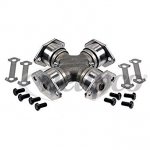aleigh
Well-known member
- 1,040
- 53
- 48
- Location
- Phoenix, AZ & Seattle, WA
I don't know what you use your truck for but if it's as bad of an issue as you suggest, then, I'd say you want it for the day you whack a weight off the shaft when offroading, or the ujoints fail for other reasons (wear, water ingress, etc). If $1000 to have the shafts spun is (500 ea was mentioned on this thread) is cheap insurance, then a vibration monitor also seems like cheap insurance.I haven't really considered using instruments to gather more vibration data. I've fixed most everything on mine now, so I'm not sure what I would find, except control data. I think if you break one "extremity engine accessory", have the driveshafts checked, and they are out of balance/runout, you've emperically found the problem. If you break multiple things and find that the driveshafts are good, that would be the real puzzler. It's unfortunate there isn't a good way to perform a driveshaft balance / runout test in the field, besides to wiggle it and look for the presence of play.
Personally what is also cheap insurance that I haven't heard mentioned here is marking the bolts and then a program of checking the engine to see if they are backing off, and safety wire (all common in other safety critical applications).





